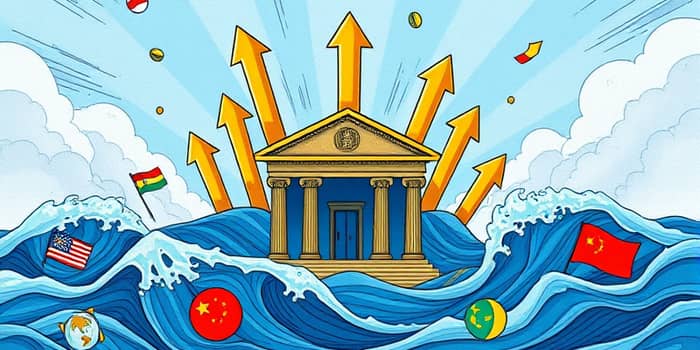
As inflationary pressures intensify and consumer spending surges, central banks around the world have embarked on a coordinated journey to curb excessive growth. By raising borrowing costs, dampening demand, and preventing runaway inflation, policymakers aim to maintain stability and long-term prosperity. This article explores the dynamics of these rate hikes, their global footprint in 2025, and practical strategies for individuals and businesses to adapt and thrive under higher interest rates.
The balance between growth and price stability is delicate. Too much stimulus stokes inflation, while overly restrictive policy risks recession. Understanding how these decisions ripple through everyday life can empower readers to make informed financial choices.
An overheating economy occurs when demand outpaces supply, pushing up wages and prices at an unsustainable pace. Goods become scarce, labor markets tighten, and consumer confidence propels spending, further fueling inflation. Central banks view this scenario with caution, as unchecked price rises erode purchasing power and destabilize markets.
Economists often monitor key indicators—such as capacity utilization, wage growth, and consumer price indexes—to assess overheating risks. When these metrics signal excessive expansion, monetary authorities step in to restore equilibrium, ensuring that growth remains within healthy bounds.
Interest rate adjustments are the primary tool for managing economic temperature. By climbing interest rates to fight inflation, central banks increase the cost of loans, which in turn discourages excessive spending and borrowing. Consumers may delay major purchases like homes and cars, while businesses postpone expansion plans, leading to moderated demand.
This cause-and-effect chain unfolds over time. After a decision to raise rates, it can take several months for the impact to flow through credit markets, consumer behavior, and ultimately price levels. This lag time between rate hikes and their full effect poses a challenge for policymakers, who must anticipate future trends rather than react to current data alone.
As of mid-2025, the landscape of interest rates and inflation is highly diverse. While some economies enjoy low, stable prices, others face persistent or hyperinflationary forces. Understanding these variations sheds light on the complex interplay between monetary policy and national circumstances.
Venezuela’s persistent hyperinflation and Russia’s steep rates contrast sharply with the ultra-low rates in Switzerland and Japan. Meanwhile, the U.S. Federal Reserve holds rates near 4.5%, signaling cautious optimism as it forecasts modest rate cuts later in 2025.
Higher interest rates ripple into everyday life, affecting mortgages, credit card rates, and corporate financing costs. In the United States, 30-year mortgage rates climbed from 3.0% in 2021 to 6.8% by June 2025, significantly raising monthly payments for homebuyers. For businesses, expensive loans can delay hiring, capex, and inventory purchases.
Consumers and firms alike face decisions: whether to refinance, delay purchases, or adjust budgets to accommodate higher debt servicing charges. These choices can shape long-term financial health and resilience during uncertain times.
By proactively managing obligations, individuals can avoid the shock of rising loan payments and preserve financial flexibility.
Policy debates often center on the speed and magnitude of rate adjustments. Move too slowly, and inflation risks become entrenched, possibly requiring even steeper hikes later. Move too quickly, and economies may slip into recession, with job losses and credit market freezes.
The U.S., UK, and EU experience this tightrope walk in real time. Although aggressive hikes in 2022-23 slowed inflation, they also raised concerns about a potential downturn. Yet, many major economies demonstrated surprising resilience, with sectors like technology and consumer staples maintaining momentum despite tighter credit conditions.
Monetary policy does not operate in a vacuum. Trade tensions, supply chain disruptions, and geopolitical crises can amplify or mute the impact of rate changes. In 2025, rising tariffs and energy price volatility have complicated central bank strategies, creating unpredictable cost pressures for consumers and firms.
Global coordination, while limited, can mitigate spillovers. For instance, synchronized decisions by major central banks can reduce currency volatility and stabilize international capital flows, offering a window of certainty in choppy markets.
Looking ahead, central banks anticipate a gradual shift toward rate cuts as inflation nears target levels. The Fed’s forecast of two cuts by year-end 2025 hints at a cautiously optimistic outlook. Yet, uncertainties remain: will inflation rebound? How will geopolitical risks evolve? What is the impact of fiscal stimulus in major economies?
For stakeholders—homeowners, investors, and business leaders—planning is essential. Consider these strategies:
Staying informed enables timely decisions, from locking in mortgage rates to adjusting business plans in high-cost financing environments.
Interest rate hikes are powerful levers that shape economic trajectories. When used judiciously, they can cool overheating markets, preserve purchasing power, and lay the groundwork for sustainable growth. Yet, they also pose challenges for borrowers and investors who must navigate volatile interest rate cycles.
By understanding the motives behind central bank decisions, recognizing global variations, and adopting proactive financial strategies, readers can transform uncertainty into opportunity. In a world where rates can climb or fall rapidly, knowledge and adaptability become the most valuable assets.
References













